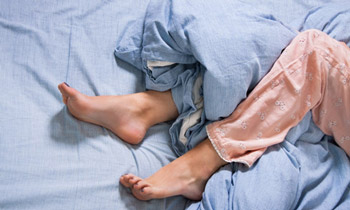3 Common Sleeping Disorder & How You Can Overcome Them
“I think I’m sleeping too much,” said no adult ever. Probably only applies to children and teenagers who are experiencing growth spurts.
“Wake up, it’s time for work!” shouted your spouse, but you realise then that you’ve not slept a wink. Sounds more like it.
If you have difficulty sleeping, know that you’re not alone. In a recent Sleep Index study by The National Sleep Foundation, it is revealed that 35% of adults suffer from sleep deprivation, while 25% reported that they did not have a refreshing sleep at least once in a week.
With this surprising data, more and more adults are getting less sleep than recommended. 7-8 hours of sleep is a guideline to help your body recuperate and repair any damages done in your body during the day, even to as little as shedding unused skin layer. The lesser the amount of sleep you get, the higher is the chances of catching the common cold.
If you’ve been having sleepless nights, in this article, you’ll be able to identify which sleeping disorder types you have, with ways on how you can overcome them.

1. Insomnia
We’re not referring to Craig David’s Insomnia song, but the situation where you’re unable to sleep for days. Insomnia is defined as someone experiencing difficulty falling asleep, difficulty maintaining sleep throughout the night or waking up too early in the morning. It usually lasts for a few days or weeks, but chronic and serious insomnia cases can go on for months at a time.
The main cause of insomnia is high-stress levels, medication and even anxiety or depression. According to the Sleep Disorder Unit SGH, “patients with persistent insomnia should be evaluated by a physician to rule out underlying depression”. While medication can be prescribed to combat insomnia, it should only be done at the very last resort. Instead, a simple modification to lifestyle should be the first order such as limiting caffeine intake close to bedtime, minimising the usage of a mobile phone close to the bed, and restriction of day-time sleep.
2. Sleep Apnoea
Obstructive Sleep Apnoea is a sleeping disorder where breathing is briefly and repeatedly interrupted during sleep, as defined by National Sleep Foundation. This is the situation when the muscles in the back of your throat fail to keep the airway open, despite efforts to breathe. Central Sleep Apnoea is another form of sleep apnoea, where the brain is unable to properly control breathing during sleep. Obstructive Sleep Apnoea is a more common type of sleep apnoea.
There are many symptoms of obstructive sleep apnoea including sleepiness in the day, morning headaches and excessively loud snoring. The first thing you should do when you’ve identified yourself as having these symptoms is to visit the doctor. It’s best you bring along a record of our sleep, identify the fatigue level you’ve been having throughout the day and any other related symptoms.
The most common and effective treatment of choice is continuous positive airway pressure device (CPAP), which is a mask that fits over the nose and/or mouth and gently blows air into the airway to keep it open during sleep. It may be challenging for your sleeping partner, but if this helps you prevent bigger problems in the future like high blood pressure, heart attack and congestive heart failure, it’s still the best solution.

3. Restless Leg Syndrome
Also known as Ekbom Syndrome and Willis-Ekbom Disease, the Restless Leg Syndrome (RLS) causes unpleasant or uncomfortable sensations in the legs and an irresistible urge to move them. It’s easily identified as a “pins and needles” sensation in the sleep and can be a painful deterrent to sleep. It is not sleep paralysis, which its sometimes confused with. Though it’s more common in women, it affects 10% of the population.
Experts aren’t certain as to what causes RLS but theorise that its likely to be hereditary. RLS often occurs in the evening or during periods of rest. Neubauer says that those who have RLS can kick or move hundreds of times a night, every single night.
The best treatment of RLS is to make some lifestyle modifications and good sleeping habits which includes maintaining a consistent sleep routine; keeping the bedroom dark, quiet and cool; keeping electronics and other distractions from the bedroom; and avoiding lying in bed awake for long periods of time. If you’re sensitive to sound when you’re sleeping, it also helps to invest in sleeping ear plugs to keep your sleeping environment quiet. It’s simple to say that good and healthy sleeping habits are the best sleeping tips anyone can give you.
If you’ve encountered any of these sleeping disorder, don’t fret. The first thing you should go is to track your sleeping patterns for 3-7 days before visiting the doctor. This will help the doctors eliminate sleep monitoring as a treatment for you, and instead help you to focus on finding the solution to your sleeping disorder. Now, you can stop searching for ways on how to sleep faster, put your phone away and force yourself to sleep.


![Clock1200x628[1]](http://www.hallning.com/wp-content/uploads/2019/09/Clock1200x6281.jpg)

